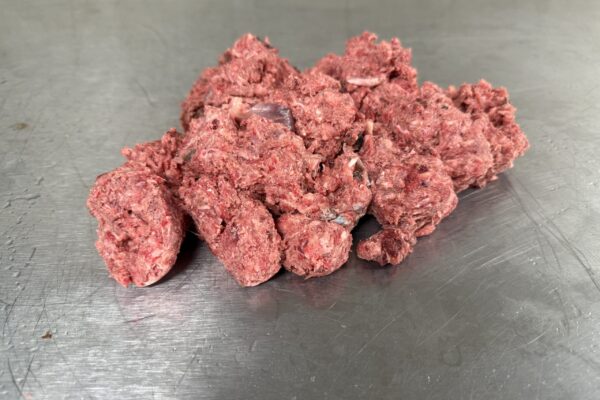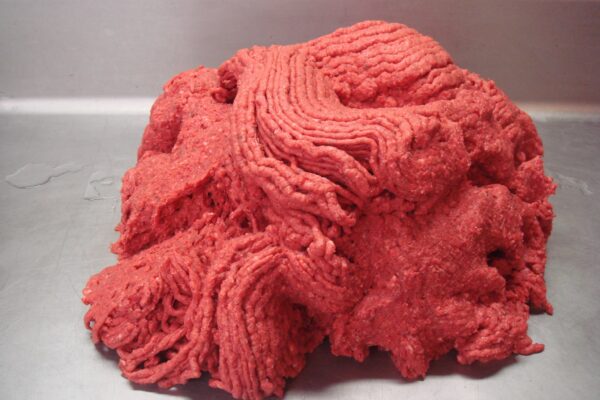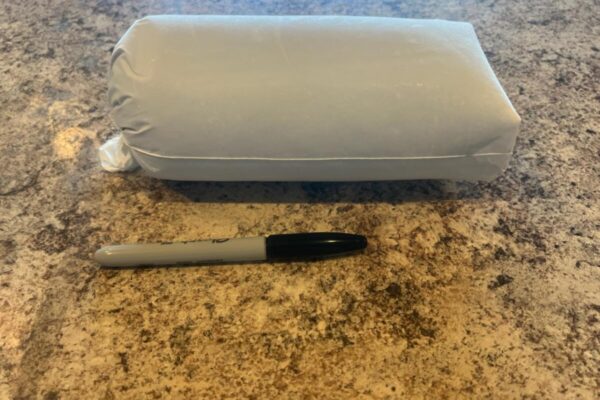— Family Owned and Operated —
Your Best Friend Deserve the Best Food
Raw Dog Food:
Raw Dog Food – Fuel for Natural Canine Health
Feeding dogs a raw diet — often called a BARF diet (Biologically Appropriate Raw Food) — gives them the kind of nutrition nature intended. At Ford’s Locker, we believe dogs thrive on real food made from fresh meat, bone, and organ blends — the way their bodies are designed to eat.
Our Ford’s RAW Dog Food is crafted to support every part of your dog’s health: a strong body, shiny coat, clean teeth, and lasting energy.
Benefits of a Raw Diet
Healthier Skin and Shinier Coat
Raw food provides essential fatty acids found naturally in meat and fish. These fats nourish the skin, reduce itchiness and irritation, and give dogs that healthy, glossy shine.
Better Dental Health
Chewing raw meat and bone helps clean teeth naturally. It reduces plaque, strengthens jaw muscles, and promotes better breath without relying on artificial additives.
Improved Digestion
Dogs digest raw foods more efficiently than kibble. That means smaller, firmer stools, fewer digestive issues, and less bloating or gas. Because raw meals are closer to what dogs eat in the wild, their systems know exactly what to do with it.
Increased Energy and Stamina
Raw diets give dogs steady, natural energy from protein and healthy fats — not the sugar spikes that come from fillers or grains.
Weight and Muscle Management
Since our raw meals are made with real ingredients and no fillers, they help dogs maintain lean muscle while avoiding excess fat. You can easily control portion size and calories for your dog’s needs.
Stronger Immune System
Whole, unprocessed foods are naturally rich in vitamins, minerals, and antioxidants — helping your dog’s immune system stay strong and resilient.
Fewer Allergies and Sensitivities
Many dogs with food allergies or skin problems improve when switched to a raw diet. Ford’s RAW avoids common irritants like grains, soy, and artificial preservatives.
Mental Stimulation
Chewing on raw meaty bones engages your dog’s instincts and provides natural enrichment, reducing boredom and destructive habits.
Introducing Ford’s RAW Dog Food
Our premium raw dog food formula is made in small batches using high-quality meats sourced in Utah and processed right here at Ford’s Locker in Provo, Utah. Each ingredient is selected to create a balanced, nutrient-rich meal that supports optimal canine health.
Ingredients:
-
Beef (65%) – High-quality protein for muscle growth and daily energy.
-
Whole Salmon (20%) – Rich in omega-3 fatty acids for healthy skin and coat.
-
Bone (10%) – Natural calcium and minerals for strong bones and teeth.
-
Liver (5%) – Packed with essential vitamins, minerals, and amino acids.
Feeding Guidelines
-
Feed 2–3% of your dog’s ideal body weight per day.
Example: a 50 lb dog would need about 1–1.5 lbs of raw food daily. -
Puppies and active dogs may require slightly more; older or less active dogs slightly less.
-
Divide into 1–2 meals per day depending on your dog’s preference.
-
Transition slowly over 7–10 days to avoid digestive upset.
A Word of Caution
Raw feeding can be highly beneficial, but it’s important to handle it safely. Always keep raw food frozen until use, thaw it in the refrigerator, and clean bowls and surfaces after feeding. Consult your veterinarian to ensure your dog’s diet is properly balanced and suitable for their specific needs.
Why Choose Ford’s RAW Dog Food
-
Made locally in Utah from fresh, USDA-inspected meats
-
No grains, fillers, preservatives, or artificial ingredients
-
Balanced formula for complete nutrition
-
Family-owned and operated for over 80 years
Feed your dog the way nature intended — fresh, wholesome, and real. Choose Ford’s RAW.
Frequently Asked Questions — Raw Dog Food & BARF Diet
1. What is raw dog food (aka BARF diet)?
Raw dog food is a diet made of uncooked muscle meat, organ meat, and raw bone (plus optional small amounts of vegetables or supplements). It’s usually designed to mimic what canines would eat in the natural, ancestral diet. This is often called a BARF (Biologically Appropriate Raw Food) or prey model raw food.
Many commercial raw diets (like Ford’s RAW) are pre-balanced to include all necessary vitamins and minerals so you don’t have to “guess” the mix.
2. What are the benefits of feeding raw dog food?
Most supporters of raw diets list advantages such as:
-
Improved coat and skin health (shinier fur, fewer skin allergies)
-
Better dental health via natural bone chewing
-
Enhanced digestion — smaller, firmer stools
-
Higher energy levels and more vitality
-
Easier weight control (no artificial fillers or high carbs)
-
Stronger immune system from whole, natural nutrients
-
Reduced food sensitivities or allergy reactions
-
Mental stimulation from chewing raw bones/meat
These claims are widely promoted by raw-food advocates. (Just note: scientific consensus is mixed, and risks exist if done incorrectly.)
3. Is raw dog food safe? What are the risks?
Yes, raw food can be safe — if handled properly — but there are risks you need to manage:
-
Bacterial contamination (Salmonella, E. coli, Listeria) is possible if raw meat is mishandled or thawed at room temperature
-
Bone hazards: cooked bones are dangerous (splintering), and even raw bones can occasionally cause obstructions or tooth injury if too large or hard
-
Nutritional imbalance if you try to build a raw diet yourself without proper knowledge
-
Shedding bacteria: dogs may shed pathogens in their stool, which could pose risks to humans in the home
-
Cost, freezer requirements, spoilage: raw diet logistics are more demanding than kibble
Because of these risks, many veterinarians caution or advise against raw diets unless you’re working with a veterinary nutritionist.
4. What are general feeding guidelines? How much raw food should I feed my dog?
Here’s a practical starting framework (always adjust based on your dog’s body condition, activity, age, and health):
|
Dog Age / Type
|
Approx Percentage of Body Weight / Day
|
Feeding Frequency
|
|---|---|---|
|
Adult, healthy, moderate activity
|
2.0% – 3.0% of ideal body weight
|
1–2 meals per day
|
|
Active or working dogs
|
2.5% – 4.0%
|
2 meals per day or more
|
|
Underweight or “hard keepers”
|
Up to 3.5% – 4.0% or more
|
2–3 meals (monitor)
|
|
Senior, less active, or overweight
|
1.5% – 2.0%
|
1–2 smaller meals
|
|
Puppies & Growing Dogs
|
4.0% – 10.0% (depending on age & growth rate)
|
3–4 meals daily when very young, taper to 2 as they mature
|
Sources: Many raw feeding guides use 2–3% of body weight for adult dogs as a rule of thumb. Bella+Duke+2PuppySimply+2
Example: If your dog weighs 50 lb (approx 22.7 kg), 2.5% of body weight = about 1.25 lb (≈ 567 g) of raw food per day, split into two meals (≈ 0.625 lb per meal).
Important notes:
-
Monitor your dog’s body condition score. You should see a defined waist and be able to feel (but not see) ribs.
-
Adjust up or down by 5–10% if your dog is gaining or losing weight.
-
You may need to feed more during growth, pregnancy, or heavy activity; less during sedentary periods.
-
Don’t leave raw food out too long — thaw in fridge or cold water, and don’t let it sit several hours at room temperature.
5. How do I transition my dog from kibble to raw food safely?
Switch gradually over 7–10 days (or longer for sensitive dogs). A sample transition plan:
-
Days 1–3: 25% raw + 75% old food
-
Days 4–6: 50% raw + 50% old
-
Days 7–9: 75% raw + 25% old
-
Day 10+: 100% raw
Monitor stool quality, energy, appetite. If diarrhea or vomiting occurs persistently, slow the transition or consult a vet. We Feed Raw+1
For very sensitive dogs, you may extend the transition over 2–3 weeks, starting with small amounts once per day and gradually growing.
6. What are ideal ingredient ratios in a raw dog food diet?
A well-balanced raw diet often follows one of these typical models:
-
Prey model: ~80% muscle meat, ~10% raw bone, ~10% organ meats (half of organs being liver)
-
BARF (modified): ~70–80% muscle meat, ~10–15% bone, ~5–10% organs, plus small amounts of fruits/vegetables/supplements
Be cautious: too much liver can cause vitamin A toxicity; too much bone can cause constipation or tooth issues. Use variety. Dog Corner+2We Feed Raw+2
7. Can I mix raw food with kibble or canned food?
Yes — it’s possible to blend raw and kibble or rotate raw and cooked meals, but there are caveats:
-
Mixing in the same meal might affect digestion or enzyme activity for some dogs.
-
Ensure both the raw and kibble are balanced and safe.
-
Use transition periods when changing mixtures.
-
Some owners prefer “partial raw” (e.g. one raw meal per day, rest kibble) to balance cost and convenience.
8. Do I need supplements with raw food?
If you choose a commercially formulated raw diet like Ford’s RAW (properly balanced), you often do not need extra supplements — everything should already be included (vitamins, minerals, omega fatty acids).
If you make your own raw meals (DIY), you may need to add:
-
Fish oil / omega-3
-
Vitamin E, D, iodine, zinc etc.
-
Digestive enzymes or probiotics
-
Kelp, algae, or greens (sparingly)
-
Bone or bone meal (if you skip raw bone entirely)
Always discuss with a veterinary nutritionist before supplementing to avoid overdosing or imbalance.
9. How do I handle and store raw dog food safely?
Food safety is critical with raw diets:
-
Keep raw food frozen until ready to thaw.
-
Thaw in the refrigerator or in a cold water bath — never at room temperature.
-
Serve in stainless steel or easily sanitized bowls.
-
Discard uneaten portions within 1–2 hours (in warm temps).
-
Wash hands, surfaces, utensils, and bowls with hot soapy water after handling.
-
Avoid cross-contamination with human food.
-
Use freezer packs, cooler bags, and insulated transporters to keep raw frozen during transport.
10. What if my dog has allergies or sensitive digestion — is raw food helpful?
Many dog owners report better results when their dog has food sensitivities, skin allergies, or digestive issues after switching to a grain-free raw diet (no fillers, artificial additives).
However:
-
It’s not guaranteed — some dogs may still react to particular proteins (e.g. beef, chicken).
-
Allergy testing might still be necessary.
-
Introduce new proteins one at a time when switching raw diets.
-
Monitor stool, skin, coat, and allergy symptoms.
11. How often should I feed my dog raw food?
-
Adult dogs: Usually 1–2 meals per day
-
Puppies / growing dogs: 3–4 meals when young, tapering to 2 meals by adulthood
-
Very small dogs: Some thrive on more frequent small meals
-
Large or giant breeds: 2 meals to reduce risk of bloat
Spacing meals (morning / evening) is common. Avoid feeding right before or after heavy exercise.
12. Is raw dog food more expensive than kibble?
Generally, yes — raw diets can cost more per pound because you’re buying fresh meat, organ meats, and bones rather than heavily processed ingredients. Also factor in the freezer cost, storage space, and time. But many owners consider it worth the health benefits.
Using locally sourced meats and efficient supply chains can reduce cost.
13. What about freezing, thawing, and shelf life?
-
Keep raw food frozen until use.
-
Once thawed, store in fridge and use within 24–48 hours (some suggest 72 hours max).
-
Do not refreeze thawed raw unless it has not fully thawed and was kept at safe temps.
-
Label packs with dates.
-
Always check for off smells or discoloration — discard if suspicious.
14. Can puppies eat raw food?
Yes — many raw feeders start puppies on raw from weaning. Key points:
-
Use higher calorie formulations to support growth.
-
Feed more percentage of body weight (4–8% or more depending on age).
-
Feed more frequent meals (3–4 times a day).
-
Monitor growth, weight, bone development — avoid overfeeding or using bone-heavy diets for rapid growth breeds.
15. Can sick dogs or dogs with health conditions be on raw food?
Possibly — but always consult a veterinarian first. Some conditions may require cooked, prescription, or therapeutic diets. Raw may or may not be safe or suitable depending on:
-
Kidney disease
-
Pancreatitis
-
Autoimmune disease
-
Cancer
-
Dental damage
A vet or veterinary nutritionist can help tailor or modify a raw diet or decide whether raw is appropriate.
16. How do I know if my dog is thriving on raw food?
Positive signs include:
-
Stable, healthy weight
-
Defined waist, easily felt ribs
-
Small, firm, low-odor stool
-
Shiny coat, healthy skin, low shedding
-
High energy, good appetite
-
No chronic digestive upset (gas, diarrhea)
-
Clean teeth, healthy gums
If you notice weight loss, poor coat, excessive stool volume, or other chronic issues, reassess diet or consult your vet.
17. How do I travel or board my dog on a raw diet?
-
Pack raw in sealed, freezer-safe containers or cooler with ice packs
-
Use freeze-dried raw if refrigeration is impractical
-
For boarding, confirm facility is comfortable with raw feeding
-
Label clearly (date, type) and pack extra bowls and handling gloves
-
Thaw in advance if possible or use cooler with frequent ice replacement
18. Can I feed raw chicken, beef, pork, or fish?
Yes, these are common protein sources in raw diets — but:
-
Fish / salmon must be fresh and properly sourced to avoid parasites
-
Pork should be handled more carefully (trichinae risk in some regions)
-
Rotate proteins to avoid overexposure
-
Always include muscle, organ, and bone components
19. Do I need to follow local laws or regulations about raw dog food?
In many regions, commercial raw pet food is regulated under pet food laws (labeling, safety). When shipping raw food, you may need to follow freezing or handling regulations. Always ensure your supplier or processing facility follows safety and regulatory standards (USDA, state inspections, etc.).
20. Why should I choose Ford’s RAW Dog Food rather than DIY raw or other brands?
Because at Ford’s Locker, we offer:
-
Locally produced raw dog food in Utah with fresh, inspectable meat
-
Balanced formulas (no guesswork) that meet canine nutritional needs
-
No fillers, no artificial additives, no preservatives
-
Convenient pickup or delivery
-
Rigorous safety, handling, and quality practices
You get all the benefits of raw feeding without the time, error risk, or nutritional guesswork.
To place an order please fill out the form below
We can only ship in 40lb increments. The raw food is shipped in a box with styrofoam lining and dry ice.



